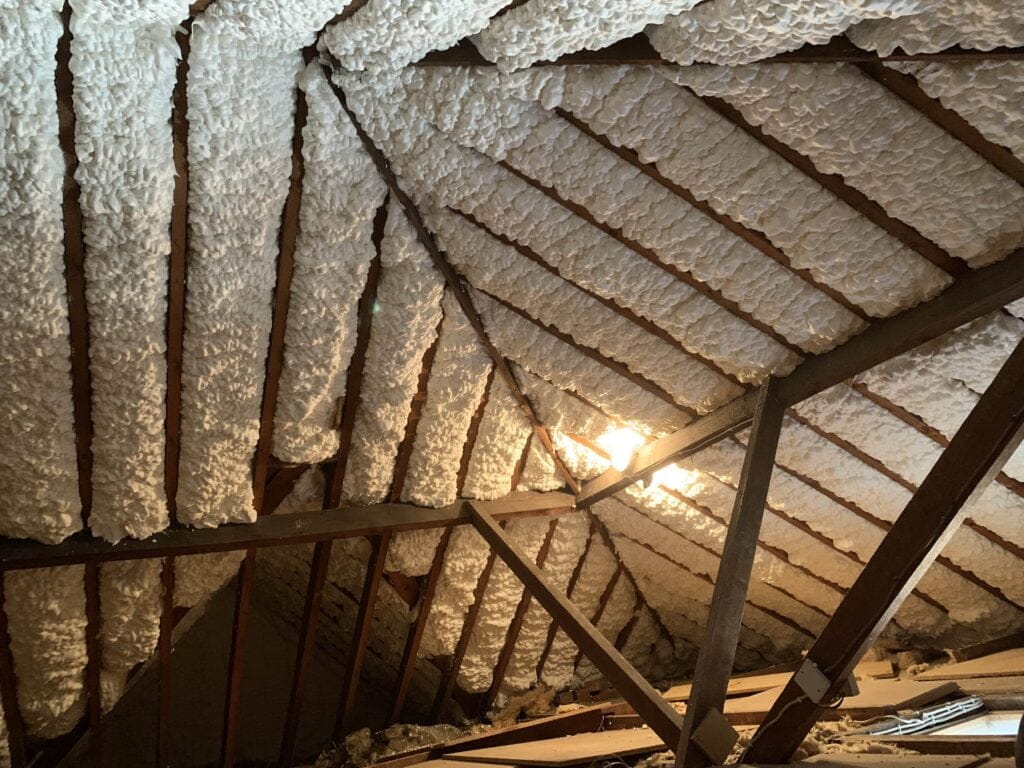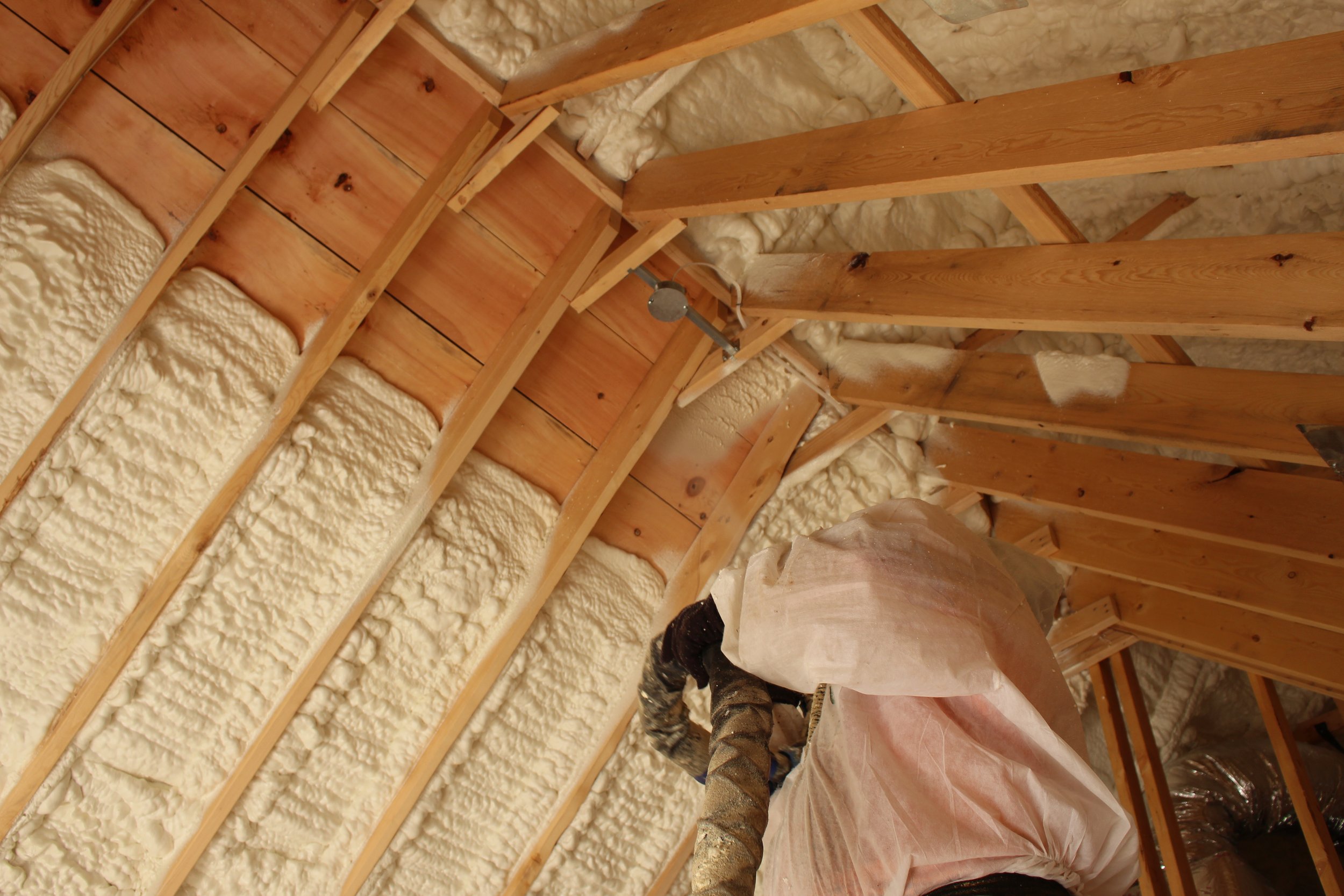Choosing the Right Sort Of Spray Foam for Your Insulation Needs
Choosing the Right Sort Of Spray Foam for Your Insulation Needs
Blog Article
Spray Foam: The Ultimate Solution for Air Sealing and Insulation
Spray foam insulation has arised as a leading remedy for efficient air securing and thermal insulation, providing an one-of-a-kind combination of buildings that establish it apart from traditional approaches. Its capacity to broaden and fill up spaces makes it particularly efficient in avoiding air leakage, which can substantially influence power effectiveness. Nevertheless, recognizing the complete extent of its advantages, installment procedures, and contrasts with other insulation kinds is important for making educated decisions. As we check out these facets, the ramifications for both new constructions and retrofits come to be significantly substantial. What elements should influence your choice?
What Is Spray Foam?
Spray foam is a versatile insulation material that combines the principles of air securing and thermal resistance to boost energy performance in structures. Composed mainly of polyurethane or various other comparable substances, spray foam is used as a fluid that expands upon call with surface areas, developing a solid, constant layer of insulation. This special residential or commercial property allows it to load spaces, splits, and voids that traditional insulation materials might ignore, offering a remarkable air seal.
There are two main sorts of spray foam: open-cell and closed-cell. Open-cell spray foam is lighter and a lot more versatile, offering outstanding sound absorption and a lower R-value per inch - Spray Foam. In comparison, closed-cell spray foam is denser, offering a greater R-value, moisture resistance, and included architectural integrity to constructing parts
The application process usually entails customized equipment, making certain a smooth application that follows different substratums, including wood, metal, and concrete. This flexibility makes spray foam appropriate for both new building and constructions and retrofitting existing structures. Its capacity to develop a closed obstacle dramatically adds to minimizing energy consumption and improving indoor air quality, therefore making it a favored option amongst contractors and house owners alike.
Advantages of Spray Foam Insulation
One of the most considerable benefits of spray foam insulation is its exceptional capacity to create a constant air barrier, which properly minimizes power loss. Unlike typical insulation products, spray foam increases to load spaces and fractures, making sure that air leak is significantly lowered. This particular not just enhances energy effectiveness but likewise causes lower utility costs in time.
Additionally, spray foam insulation provides superior thermal resistance, adding to a more stable interior setting. Its high R-value per inch enables effective insulation in confined rooms, making it suitable for attic rooms, wall surfaces, and crawl rooms. Moreover, the moisture-resistant residential or commercial properties of spray foam help avoid mold and mildew and mildew growth, promoting healthier living problems.
Another critical benefit of spray foam insulation is its sound-dampening qualities (Spray Foam). It successfully decreases sound transmission in between spaces, producing a quieter and extra comfortable home setting. The resilience of spray foam likewise stands apart, as it does not sag or resolve over time, keeping its performance throughout its life-span
Just How Spray Foam Works
Understanding just how spray foam insulation functions is important for appreciating its performance in web link air sealing and thermal resistance. Spray foam insulation includes two key components: isocyanate and polyol material. When these parts are blended, they undergo a chemical reaction that triggers the material to broaden quickly, producing a thick foam that look at this now fills spaces, dental caries, and fractures.
As the foam broadens, it sticks to surface areas, forming an airtight seal that considerably decreases air seepage. This particular makes spray foam insulation highly efficient at protecting against drafts and moisture infiltration, which can cause energy loss and damages over time. In addition, the closed-cell variation of spray foam supplies premium thermal resistance because of its inflexible structure, successfully minimizing heat transfer.
The unique buildings of spray foam enable it to comply with uneven surfaces, making sure thorough insurance coverage and a seamless barrier. Consequently, spray foam insulation not just improves power performance yet additionally adds to boosted interior air quality by lowering the buildup of irritants and contaminants. Ultimately, understanding the auto mechanics behind spray foam underscores its duty as a premium choice for insulation and air securing in both property and commercial applications.
Installation Process Overview

Prior to installment, the room must be adequately cleansed and prepped, guaranteeing that surfaces are totally free from dirt, wetness, and particles. Since contaminants can endanger adhesion and total efficiency, this step is crucial. When the location is prepared, the application involves mixing the two components of the spray foam, which expands upon contact and fills up gaps effectively.
Trained professionals need to perform the installation, making use of customized tools to guarantee consistent insurance coverage and optimal density. Security precautions, consisting of wearing safety equipment and guaranteeing appropriate ventilation, are essential throughout this procedure. After application, the foam generally treatments promptly, creating a solid obstacle that improves power performance.
Contrasting Spray Foam to Conventional Insulation
When evaluating insulation options, spray foam insulation stands out in contrast to standard materials such as fiberglass and cellulose. Unlike fiberglass and cellulose, which can allow air infiltration, spray foam expands upon application, filling holes and spaces to produce an impermeable seal.
Furthermore, spray foam provides a greater R-value per inch than conventional insulation types, using more effective thermal resistance in a thinner profile. This characteristic is especially advantageous precede with minimal tooth cavity depth. Additionally, spray foam is immune to moisture and mold development, which can be a substantial worry about cellulose and fiberglass, particularly in damp environments.
Nevertheless, spray foam insulation generally brings a greater in advance cost than its typical counterparts. Homeowners should consider this initial investment against long-lasting energy financial savings and efficiency advantages. Ultimately, while both insulation kinds offer their purpose, spray foam arises as an advanced option for try this web-site modern-day insulation needs, specifically in regards to air securing and thermal effectiveness.

Verdict
In summary, spray foam insulation stands for a very effective service for achieving optimal air securing and thermal resistance. Its unique homes, consisting of wetness resistance and audio dampening, make it ideal for various applications in both brand-new buildings and retrofitting jobs (Spray Foam). The first costs might be higher compared to conventional insulation products, the long-lasting benefits, such as significant energy cost savings and boosted interior air top quality, justify the investment and highlight its worth in modern structure methods.
Spray foam insulation has actually arised as a leading remedy for effective air securing and thermal insulation, providing a special combination of buildings that set it apart from standard techniques.Spray foam is a versatile insulation material that incorporates the concepts of air securing and thermal resistance to enhance power efficiency in buildings.When assessing insulation alternatives, spray foam insulation stands out in comparison to standard materials such as fiberglass and cellulose. Ultimately, while both insulation types offer their objective, spray foam arises as a more innovative remedy for contemporary insulation needs, specifically in terms of air securing and thermal effectiveness.
In summary, spray foam insulation represents a highly reliable solution for attaining ideal air sealing and thermal resistance.
Report this page